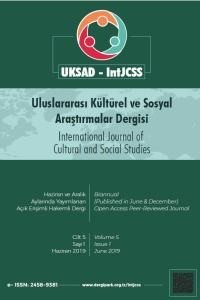Edebiyat ve Mekân Bağlamında Safiye Erol’un Ülker Fırtınası Romanı Üzerine Bir İnceleme
Edebiyatın mekân tasavvuru,
bireysel ve toplumsal hassasiyetlerin; geçmiş, şimdi, gelecek düzleminde
gösterdiği duyarlılığın görüntüleri olarak da düşünülebilir. Mekânlar, edebi
eserlerde hatırlamanın, nostaljinin, kültürel birikimin, sosyolojik değişimin,
insan ruhunu anlama çabalarının bir parçası olarak somut gerçeklikleri birer
olgu yahut duyguya dönüştürür.
Edebiyatın belirgin özelliklerinden
biri de, gerçeklik algısına hem nesnel ölçütleri kullanarak hem de bu
ölçütlerin sınırlarını zorlayarak ulaşabilmesidir. Edebiyat, nesnel ölçütlerini
yalnızca karakter tasviri ve vak’a zincirinde kaybetmez. Farklı
duygulanmaların, biçimlendirmelerin, mesajların görünür olabilmesi için mekân
tasavvuru ve tasviri nesnel ölçütlere uyularak ön plana çıkarabilir. Yanı sıra
zihinsel atmosferin çabuk ilerleyen ya da durağan göstergesi; geçmiş duygusunu
çevreleyen, gelecek tasavvurunu biçimlendiren atmosferin belirleyici unsuru
olarak mekân algısında nesnellik sınırlarını zorlayabilir. Bu nedenle edebi
eserlerde mekân kullanımının pek çok farklı anlam boyutları vardır. Mekânlar,
edebi eserde temayı destekleyen katmanlı ve kurgusal yapılanmayı somutlaştıran
bir görünürlükle inşa edilebilir. Kahramanların duygularına eşlik eden ya da
kurgunun ilerleyişini tamamlayan atmosferin görünür yüzü olabileceği gibi
anlatının, anlatıdaki tema ve duyguların; insan ve insanın değişme hallerinin
kaydedildiği hafızalar olarak da görülür. Bu nedenle edebi eserdeki mekân
kullanımı, metin içi (kurgusal) ve metin dışı (toplumsal) yapıların
çözümlenmesinde öncelikli unsurlardan biridir.
Safiye Erol’un Ülker Fırtınası
(1946) romanının da -mekân bağlamında metin içi ve metin dışı unsurları
çözümlemede- anlamlı bir örnek olduğu söylenebilir. Bu romanda mekânlar,
kurgunun odağında yer alan aşkın ölümsüzlük, bütünleşme, ayrılık gibi
hallerinin en önemli tanığı olduğu gibi toplumsal değişimi görünür hale getiren
önemli bir gösterge olma işlevini de yerine getirmektedir.
Bu bildiride genelde edebiyat mekân
ilişkisinin boyutları; özelde Safiye Erol’un Ülker Fırtınası romanında
mekân kullanımı ve bu kullanımın önce yapıta etkileri sonra bireysel ve
toplumsal anlamda nesnel gerçekliğin görüntülenmesine katkıları incelenecektir.
A Study on Safiye Erol’s Novel Ülker Fırtınası in the Context of Literature and Space
The description of space in
literature can be considered as the images of the sensibility which was shown
by the individual and social sensitiveness in the perspective of past, present
and future. In literary works, spaces transforms the realities into facts or
senses as the parts of remembering, nostalgia, cultural background,
sociological change and the effort to understand human soul.One of the significant
characteristics of literature is its ability to reach the sense of reality by
both using and pushing the limits of objective criterions. Literature not only
loses its objective criterions in character descriptions and chain of events
but also it can push the limits of them in the perception of space as the
determining factor of the atmosphere which forms the concept of the future and
surrounds the sense of the past and as the fast-going or stable indicator of
mental atmosphere. Thus, in literary works, there are many meaning dimensions
of using space. Spaces can be built with an appearence which concretizes the
stratified and fictional set-up supporting the theme. It can be both the
apperent side of the atmosphere which completes the fiction or accompanies the
feelings of the heroes and memories on which the theme, emotions and
individuals are recorded. Therefore, using space in a literary work is one of
the prior issues in analysing the fictional and social structures.It can be said that Safiye Erol’s
novel “Ülker Fırtınası (1944)” is a significant example to analyse
fictional and social elements according to concept of space. In this novel,
spaces are not only the most important
witnesses of love and its features such as immortality, being one soul and
breaking up which are on the center of the fiction but also an indicator which
makes the social change obvious.
In this study, in general, the
aspects of the relation between literature and space is analysed. Then,
specifically, the usage of space in Safiye Erol’s novel “Ülker Fırtınası”
and its contrubutions to reveal the objective reality in social and individual
senses are examined.
___
- Bachelard, G. (1996). Mekânın Poetikası, (Çev. Aykut Derman), İstanbul: Kesit Yayıncılık.
- Benjamin, W. (2002). Pasajlar, (Çev. Ahmet Cemal), İstanbul: Yapı Kredi Yayınları.
- Erol, S. (2001). Ülker Fırtınası, İstanbul: Kubbealtı Neşriyatı.
- Hisar, A.Ş. (1997). Boğaziçi Mehtapları, İstanbul: Bağlam Yayınları.
- İleri, S. (2010). “Defterimde Safiye Erol”, Zaman Gazetesi, 27 Şubat 2010.
- Keyder, Ç. [Derleyen.] (2000). İstanbul Küresel ile Yerel Arasında, İstanbul: Metis Yayınları.
- Komisyon 2016). Türkçe Sözlük, TDK Yayınları, http://www.tdk.gov.tr/index.php?option=com_gts ET: 18.10.2016
- Öner, H. (2015). Bir Dünya Cenneti Kadıköy ve Edebiyatımız, Ankara: Serüven Yayınları.
- Tekin, M. (2001). Roman Sanatı Romanın Unsurları, İstanbul: Ötüken Yayınları.
- Urry, J. (1999). Mekânları Tüketmek, (Çev. Rahmi G. Öğdül), İstanbul: Ayrıntı Yayınları.
